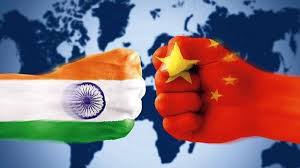India is at the centre of the American and Russian strategies to thwart Chinese ambitions to dominate their respective spheres of influence, namely the Indo-Pacific and the Eurasian regions. If China is not stopped at Himalayan heights now, its appetite for further aggrandizement may see no bounds
By Prasad Nallapati
The international community has deep misgivings over China’s revisionist global doctrine to re-order the world in its own image, but most countries are content with harnessing its economic and demographic power for monetary windfall or to counterbalance their rivals.
The best examples of this “love-hate dual-personality” are none other than the United States and Russia themselves who have swallowed their disdain for the communist regime and embraced it to outmaneuver the other.
India is at the Fulcrum of Indo-Pacific Strategy
Reversing the two-decade long US policy, the Nixon-Kissinger duo courted Mao’s China as a counterweight to Russia’s predecessor, the Soviet Union, and elevated Beijing to the permanent membership of the UN Security Council. China soon proved to be a `gold mine’ as Beijing lured not just the US but all its allies to invest their money and technology in the country to reap amazing profits.
Successive administrations have soon realized China’s strategic intent to challenge American supremacy and hence tried to restrict access to advanced weaponry but did not want to go further as the financial allurements are too tempting to antagonize the Communist regime. Even the hardline policies of the Trump administration toward Beijing are faced with serious hurdles as the Wall Street and Silicon Valley would not go by its policy of decoupling with Chinese economy for obvious reasons. The policy alternative devised was to create a new alliance of regional powers that would collectively stifle the Chinese moves. This Indo-Pacific Strategy has India at its fulcrum.
Russia’s Eurasia Strategy Places India in Balancing Role
Russia too has come up with a similar though more complex strategy to coopt India into Eurasian regional organisations as a counterbalance to China, on which Moscow had come to depend in outflanking American pressures. President Vladimir Putin, who took power from Boris Yeltsin in December 1999, had initially held that Russia was a European power and tried to steer Moscow closer to western countries. He had even once shown willingness to join the NATO.
But Washington had serious misgivings of Putin’s intentions as the latter was trying to regroup former Soviet republics under Russian leadership. The Bush administration, which came to power in 2001, had soon instigated “Colour Revolutions” in the former Soviet Republics, like Georgia, Ukraine, Kyrgyzstan, Uzbekistan etc., against Russian influence. It also backed the notorious oligarchs, who among themselves controlled much of Russian economy, particularly Mikhail Khodorkovsky, to destabilize Putin’s presidency.
Putin’s response was swift and decisive, but he was not yet ready to cozy up with China. He got Khodorkovsky arrested, his oil company Yukos was disbanded and an agreement he had signed with China to lay an oil pipeline to its port in Daqing was cancelled. Kremlin instead reoriented the eastern pipeline to Nakhodka, on the Pacific, to supply oil to multiple customers, including China, Japan, South Korea, and even the US. Russia only relented and entered into exclusive supply agreements with China when the latter was quietly pursuing independent energy contracts with Kazakhstan, Uzbekistan and Turkmenistan, bypassing Moscow.
Russia viewed China as a rival in Central Asia but considered it a lesser evil than the US. It was therefore willing to tolerate a stronger Chinese role in Central Asia to serve as a counter to the US. Moscow saw the Shanghai Cooperation Organisation (SCO), combining Russia, China and Central Asian Republics (CARs), as a vehicle to neutralize the US influence in the region. As Russia was economically weak, Beijing was expected to fund developmental programs in CARs while Moscow sought to retain political and military control. The first ever military exercise of the SCO, “Peace Mission 2005”, was part of this Russian mission.
However, Russia was conscious of its junior role in the SCO due to its structural weaknesses and China’s intentions to use the organisation to perpetuate its dominance in the region. Putin, therefore, saw a potential in India, whose economy was also growing at nearly 8 percent, that can act as a countervailing force against China and thus roped it into the SCO in 2005, initially as an observer as per the organisation’s rules. It became a full member in 2017. Moscow, however, had to swallow Beijing’s bitter pill to simultaneously admit Pakistan into the group as its balancer to India.
India is thus at the centre of the American and Russian strategies to thwart Chinese ambitions to dominate their respective spheres of influence, namely the Indo-Pacific and the Eurasian regions. China is even otherwise a serious rival to India and hence there is a natural synergy between the policies of India on one side and that of the US and Russia on the other.
India Needs Both US and Russia to Stop China in its Tracks
The question, however, is whether the US and Russia are prepared to empower India to play the intended role.
There are powerful voices in both these countries calling upon India to break with the other and become full alliance partner with themselves. This is a peculiar situation that limits India’s ability to take on China in full measure. India’s relations with Russia are long-term and time tested. The two held together through thick and thin and helped each other in their most critical times. Similarly, the US and India are natural allies with shared interests. Their multifaceted relationship bloomed over the past twenty years and destined to play a significant strategic role in maintaining international stability.
India can play a more meaningful role in the efforts to thwart China’s highly violent behaviour if both the US and Russia facilitate New Delhi complete freedom of action in choosing the ways to do so. India needs Russian support to defuse Chinese adventures in the Himalayan zone and Central Asia, while its collaboration with the US and its allies could send a strong message of upholding international law in the Indo-Pacific. However, the two have reservations over each other’s role in their respective zones.
The onus is, therefore, on India to work toward removing their apprehensions by drawing both of them into its plans. India’s invitation to Russia to be an active partner in the Indo-Pacific region is part of that effort. This may prove ultimately to be a facilitator of better understanding between the two big powers with positive consequences for world peace.
In the near term, however, there is just no prospect of the US and Russia working together, nor there is any possibility of disconnecting Moscow from Beijing. But they must recognize their responsibility in creating the monster out of the Communist regime in their attempts to undercut each other. American financial and technical assistance coupled with Russia’s liberal energy and military supplies emboldened China to feel itself invincible.
Forcing China to vacate the newly occupied areas inside India’s Line of Actual Control (LAC) and return to status quo ante as existed in April this year would be the right recipe to puncture China’s grandiose global designs. Russia’s unique relations with both India and China facilitated it to play an honest broker but it has limitations in nudging Beijing to step back. However, its other actions of fast-tracking military supplies to India, despite Chinese protests, sends a clear message. France and Israel have always proven to be reliable suppliers in such crises without even asking for payment. This is now a test for the US and its regional allies like Japan and Australia to rise to the occasion in the aid of India.
If China is not stopped at Himalayan heights now, its appetite for further aggrandizement may see no bounds.
(Prasad Nallapati is President of the Hyderabad-based think tank, the Centre for Asia-Africa Policy Research and former Additional Secretary to the Govt of India)




